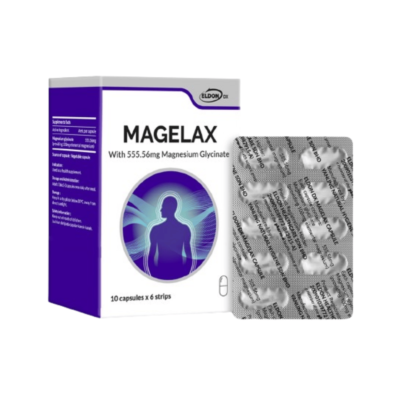This health article has been professionally reviewed by RPh Chong Kai Qian (020209), a registered pharmacist under the Malaysia Pharmacy Board (LFM).
Migraines are more than just bad headaches, they are complex neurological events that can significantly impact quality of life. The symptoms including recurring episodes of moderate to severe headaches, often on one side of the head, and commonly accompanied by nausea, as well as increased sensitivity to light and sound (1). Managing migraines effectively is not just about treating pain during an attack; it also means reducing how often those attacks happen.
Studies have shown that people who suffer from migraines tend to have lower levels of magnesium in their bodies compared to those who don’t (2, 3). Magnesium plays a vital role in many processes linked to brain and nerve health, making it a key nutrient worth understanding. Recognizing this, both the American Headache Society and the American Academy of Neurology recommend magnesium as a preventive treatment for people with frequent migraines (4). But how exactly does magnesium help with migraines?
1. Calming the Brain: Magnesium as an N-Methyl-D-aspartate (NMDA) Receptor Antagonist (5)
Think of your brain like a car. During a migraine, certain receptors, especially the NMDA receptors, get overstimulated, like pushing the gas pedal too hard. This leads to overactive nerve signals, inflammation, and pain. Magnesium works like a natural brake pedal, calming these receptors and reducing neuronal overactivity that can trigger a migraine. From the findings, oral magnesium supplementation may reduce migraine frequency by up to 41% compared to a placebo. It has also been shown to help decrease the duration and intensity of migraine attacks (6, 7).

2. Supports Blood Vessel Health in the Brain (8)
Migraines are often linked with changes in blood flow in the brain. Magnesium helps regulate the tone of blood vessels, preventing abnormal constriction and dilation of brain arteries that can contribute to migraine pain.
3. Reduces Inflammation by Blocking CGRP (8)
During a migraine, your body releases inflammatory molecules, including CGRP (Calcitonin Gene-Related Peptide)—a key contributor to migraine pain. Magnesium helps suppress CGRP release, reducing inflammation and discomfort, thereby lowering the likelihood of a migraine attack.
Magnesium is not a cure-all, but for many people, it is a powerful, research-backed addition to a migraine prevention plan. By calming overactive neurons, supporting vascular health, and reducing inflammation, magnesium addresses the root causes of the problem, not just the symptoms. Magnesium is naturally present in many plant- and animal-based foods, such as green leafy vegetables, legumes, nuts, seeds, and whole grains. However, getting the effective dose through diet alone can be challenging. Whether you are a healthcare provider looking to expand treatment options or patient living with migraine, consideration of magnesium supplmentation is highly encouraged. Learn more about Magnesium!
Disclaimer: The information provided is for general knowledge and informational purposes only and should not be considered as medical advice or a substitute for professional consultation, diagnosis, or treatment. Always seek the advice of a qualified healthcare provider with any questions regarding a medical condition.
Reference:
- National Institute of Neurological Disorders and Stroke. (2025, February). Migraine. National Institutes of Health. Retrieved June 11, 2025, from https://www.ninds.nih.gov/healthinformation/disorders/migraine#toc-what-is-migraine
- Karim, M. R., Bhattacharjee, M., Islam, M. S., Banerjee, S., Hossain, S., Hossain, M. I., & Haidar, M. R. (2021). Relation between Serum Magnesium Level and Migraine. Mymensingh medical journal : MMJ, 30(2), 301–306.
- Dominguez, L. J., Veronese, N., Sabico, S., Al-Daghri, N. M., & Barbagallo, M. (2025). Magnesium and Migraine. Nutrients, 17(4), 725. https://doi.org/10.3390/nu17040725
- Holland, S., Silberstein, S. D., Freitag, F., Dodick, D. W., Argoff, C., Ashman, E., & Quality Standards Subcommittee of the American Academy of Neurology and the American Headache Society (2012). Evidence-based guideline update: NSAIDs and other complementary treatments for episodic migraine prevention in adults: report of the Quality Standards Subcommittee of the American Academy of Neurology and the American Headache Society. Neurology, 78(17), 1346–1353. https://doi.org/10.1212/WNL.0b013e3182535d0c
- Elgar K. (2022) Magnesium: A Review of Clinical Use and Efficacy. Nutr Med J., 1 (1): 79-99.
- Peikert, A., Wilimzig, C., & Köhne-Volland, R. (1996). Prophylaxis of migraine with oral magnesium: Results from a prospective, multi-center, placebo-controlled, and double-blind randomized study. Cephalalgia, 16(4), 257–263.
- Chiu, H. Y., Yeh, T. H., Huang, Y. C., & Chen, P. Y. (2016). Effects of Intravenous and Oral Magnesium on Reducing Migraine: A Meta-analysis of Randomized Controlled Trials. Pain physician, 19(1), E97–E112.
- Kirkland, A. E., Sarlo, G. L., & Holton, K. F. (2018). The Role of Magnesium in Neurological Disorders. Nutrients, 10(6), 730. https://doi.org/10.3390/nu1006073







